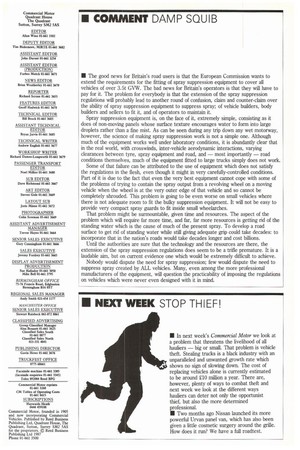• COMMENT DAMP SQUIB
Page 5

If you've noticed an error in this article please click here to report it so we can fix it.
• The good news for Britain's road users is that the European Commission wants to extend the requirements for the fitting of spray suppression equipment to cover all vehicles of over 3.5t GVW. The bad news for Britain's operators is that they will have to pay for it. The problem for everybody is that the extension of the spray suppression regulations will probably lead to another round of confusion, claim and counter-claim over the ability of spray suppression equipment to suppress spray; of vehicle builders, body builders and sellers to fit it, and of operators to maintain it.
Spray suppression equipment is, on the face of it, extremely simple, consisting as it does of non-moving panels whose surface texture encourages water to form into large droplets rather than a fine mist. As can be seen during any trip down any wet motorway, however, the science of making spray suppression work is not a simple one. Although much of the equipment works well under laboratory conditions, it is abundantly clear that in the real world, with crosswinds, inter-vehicle aerodynamic interactions, varying clearances between tyre, spray equipment and road, and — most importantly — road conditions themselves, much of the equipment fitted to large trucks simply does not work.
Some of that failure can be attributed to the use of equipment which does not satisfy the regulations in the flesh, even though it might in very carefully-controlled conditions. Part of it is due to the fact that even the very best equipment cannot cope with some of the problems of trying to contain the spray output from a revolving wheel on a moving vehicle when the wheel is at the very outer edge of that vehicle and so cannot be completely shrouded. This problem is going to be even worse on small vehicles where there is not adequate room to fit the bulky suppression equipment. It will not be easy to provide very compact spray guards to fit inside small wheelarches.
That problem might be surmountable, given time and resources. The aspect of the problem which will require far more time, and far, far more resources is getting rid of the standing water which is the cause of much of the present spray. To develop a road surface to get rid of standing water while still giving adequate grip could take decades: to incorporate that in the nation's roads would take decades longer and cost billions.
Until the authorities are sure that the technology and the resources are there, the extension of the spray suppression regulations does seem to be a trifle premature. It is a laudable aim, but on current evidence one which would he extremely difficult to achieve.
Nobody would dispute the need for spray suppression; few would dispute the need to suppress spray created by ALL vehicles. Many, even among the more professional manufacturers of the equipment, will question the practicability of imposing the regulations on vehicles which were never even designed with it in mind.




















































































